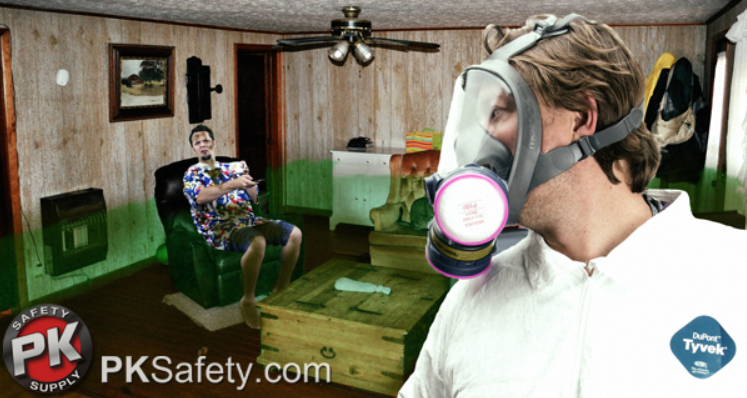
Clean up from superstorm Sandy is going to take time. One of the ongoing problems the residents who saw flooding will face is getting rid of the mold. As they reclaim their houses and businesses, they are finding flooring, chairs, walls, and other porous materials that have been wet for more than a couple of days are accumulating mold colonies.
The longer the mold is allowed to continue to grow, the more dangerous it becomes to people operating in the area, and the more difficult it becomes to remove. Here are some steps to take and suggestions on the best personal protective gear to wear while removing mold from your homes and offices.
Once flood waters have receded and it's safe to enter your home or business, it's time to start drying out. The EPA suggests taking pictures to document for insurance purposes, but don't delay the clean-up. Remove wet carpeting and carpet padding first thing. Next cut away all wet wallboard and get rid of soggy insulation. Even if it's just damp, it will take too long to dry out. If left alone, dampness inside walls will lead to decay and mold growth where it won't be seen.
Mold is looking for a wet, warm place to grow. Since the spores can become airborne, one of the places mold can find purchase is in the mucus membrane of the eye. It's for this reason the best protection for mold remediation includes a full-face respirator. These masks work well for keeping the mold out, and a smart design helps to cut way down on fogging.
The full face respirator mold kit includes a pair of Moldex 7600 Multi-Gas Vapor Cartridges, a connector, and a pair of Moldex 7940 P100 Filter Disks which remove particles down to .03 microns which is the highest level of protection available. The unit taken as a whole protects eyes, face (from falling debris), and lungs, while providing a large clear screen to see what you are doing.
Clean up by wiping everything that's left down with non-phosphate detergents. Residual phosphates are mold food, so you don't want that around for the spores to use. And remember, disinfectants can kill mold, but don't prevent it growing back again so you need to get things dried out. Heavier Nitrile Gloves like the old dish-washing gloves are a great way to protect the hands from detergents, bleach, and to keep the mold spores away from any cuts or scrapes on your hands.
You are going to want to do everything you can to complete the dry out process of subfloors, wall framing, and slabs as swiftly as possible. Special equipment like dehumidifying blowers can be the most effective, but heaters and air conditioners running practically continually will also work well.
Lots of folks may be trying to dry out areas that don't have electricity yet. Remember, it's a bad idea to run a generator in an enclosed space. Automatic Carbon Monoxide shut-offs on generators don't always work, and you may be creating a more deadly environment than the moldy one if an internal combustion engine is allowed to run in a space without adequate ventilation.
If you have questions about what to wear to safely remove mold, give us a call, or chat with us online. We carry all the gear professional mold remediation companies use, and can explain what you need for your specific situation. Stay dry, stay safe, and reclaim your spaces the right way.
Postscript - Because of the high volume of calls we have been receiving about mold cleanup, we've put together a Mold Remediation and Cleanup Kit to make sure folks have the right protective clothing for the job.
